Introduction
In a world where workplace stress is an ever-present challenge, the power of restorative practices often goes overlooked. Resting poses in yoga serve as essential tools for enhancing both physical and mental well-being, offering a much-needed respite from the demands of daily life. By integrating these poses into a regular routine, individuals can experience profound benefits that extend beyond the mat, fostering recovery, clarity, and motivation.
As organizations increasingly recognize the importance of employee wellness, embracing these restorative moments can lead to a more engaged and productive workforce. This article explores the significance of resting poses, provides essential techniques to incorporate them into daily practices, and highlights the compelling advantages they bring to both individuals and teams in the workplace.
The Importance of Resting Poses in Yoga Practice
Resting poses in practice, often undervalued, are essential for promoting overall well-being and can greatly improve workplace performance. They provide a vital opportunity for practitioners to pause, reflect, and rejuvenate both physically and mentally. In our modern work environment, marked by constant stress and fatigue, incorporating resting poses into your routine, along with regular exercise, can lead to significant improvements in relaxation, recovery, and motivation.
A study published in 'Preventive Medicine' found that employees who exercised regularly for at least 30 minutes three times per week reported feeling 20% more motivated at work than their sedentary counterparts. By embracing these restorative moments, you facilitate improved circulation, alleviate muscle tension, and cultivate mental clarity—elements that are essential for sustaining focus and productivity throughout the day. Notably, a recent study found that a weekly 90-minute class, complemented by home practice over six months, significantly enhances life satisfaction, with participants reporting a 30% increase in overall well-being.
While the benefits of yoga and regular exercise are becoming increasingly recognized, it is essential to acknowledge that further rigorous research is needed to understand the effectiveness of various yoga programs. By prioritizing resting poses and promoting a culture of regular exercise, HR Benefits Managers can champion employee well-being, ultimately leading to a more engaged and productive workforce.
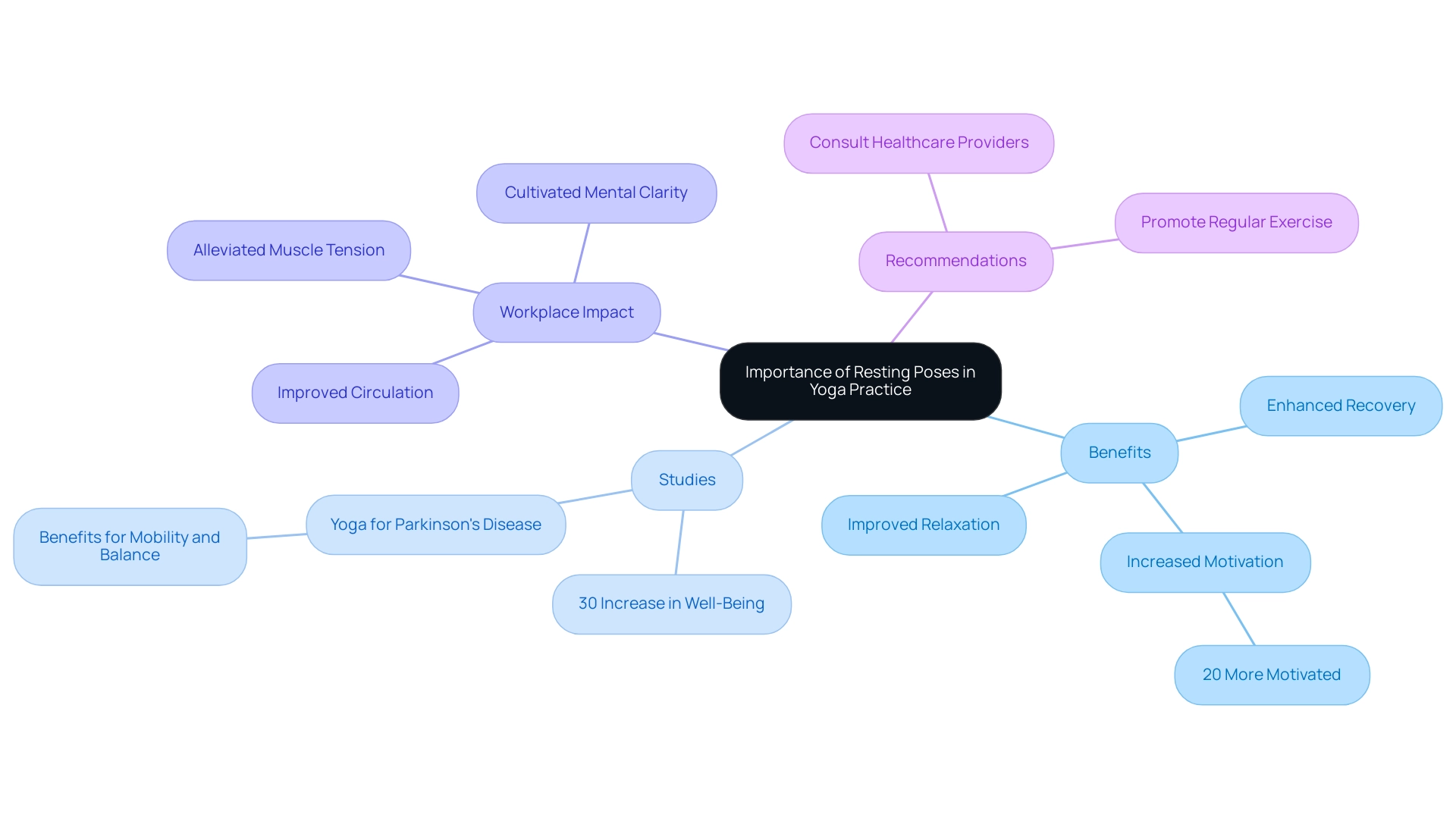
7 Essential Resting Poses to Enhance Your Yoga Practice
- Child’s Position (Balasana): A fundamental resting pose, Child's Position offers a gentle stretch for the back and is renowned for its ability to relieve tension. This position not only encourages relaxation but also soothes the mind, making it an ideal enhancement to any exercise routine. Notably, recent studies indicate that yoga practices such as Child’s Position can elevate levels of GABA, a neurotransmitter associated with improved mood and reduced anxiety. According to the case study titled 'Anatomy of Child’s Position,' this position relaxes the front body muscles while passively stretching the back muscles, promoting ease in all muscles, particularly in the upper back and rhomboids.
- Legs-Up-the-Wall Position (Viparita Karani): This restorative position is essential for enhancing circulation and reducing swelling in the legs, particularly beneficial after workouts. It allows the body to rejuvenate by promoting blood flow and aids in recovery, making it a favorite among practitioners for its restorative qualities.
- Corpse Position (Savasana): Often regarded as the ultimate relaxation position, Savasana is typically practiced at the conclusion of a yoga session. This position fosters deep mindfulness and relaxation, encouraging practitioners to absorb the benefits of their practice fully. It is an essential tool for stress management, allowing individuals to disconnect and recharge.
- Reclining Bound Angle Position (Supta Baddha Konasana): This position is a gentle opener for the hips, fostering a sense of peace and tranquility. It serves as a perfect antidote for stress, promoting a feeling of calm and relaxation, which is vital in today’s fast-paced work environment.
- Supported Bridge Position (Setu Bandhasana): This position strengthens the back while providing a gentle stretch across the body, promoting relaxation and rejuvenation. It is particularly helpful for counteracting the effects of prolonged sitting, making it a beneficial choice for office workers.
- Seated Forward Bend (Paschimottanasana): Known for its calming effects, this asana stretches the spine and hamstrings, fostering tranquility and introspection. It encourages a moment of stillness, allowing individuals to reconnect with their breath and center themselves amid chaos.
- Supported Fish Position (Matsyasana): A powerful position for opening the chest, Supported Fish Position encourages deep, restorative breathing. This enhances relaxation and can significantly reduce anxiety, making it a great practice for individuals seeking to improve their mental well-being.
Authorities such as orthopedic surgeon Ray Long, who has carefully researched hatha practices for more than twenty years, stress the significance of including these vital resting poses in everyday routines. He states, "The incorporation of these not only enhances physical health but also creates a holistic approach to well-being that HR Benefits Managers can advocate for their teams.
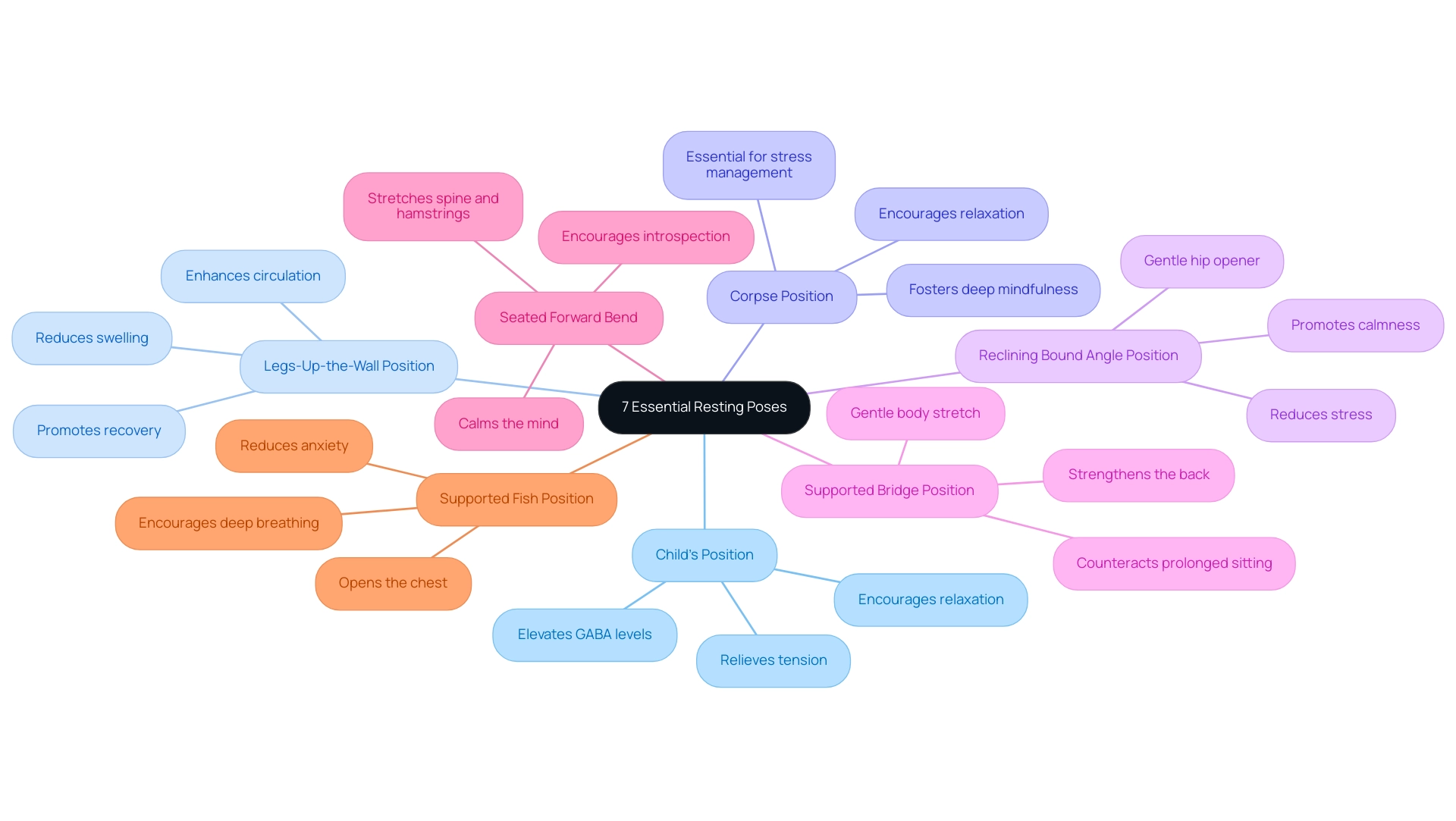
Benefits of Incorporating Resting Poses into Your Routine
Integrating resting poses into your practice provides numerous advantages that reach well beyond the mat. These poses not only facilitate physical recovery by alleviating muscle tension and enhancing flexibility, but they are also vital for preventing injuries—particularly in corporate environments where sedentary behavior is prevalent. For example, a recent study revealed that this practice can significantly enhance the quality of life for individuals facing chronic diseases, showcasing its potential for a healthier workplace.
Notably, a study published in 2020 showed a reduction in cigarette cravings after a single session of the practice, illustrating the immediate benefits that could resonate with HR Benefits Managers considering wellness programs. On a mental level, resting poses encourage mindfulness and stress reduction, empowering practitioners to cultivate a sense of calm and clarity. This mindfulness aspect is crucial; expert opinions highlight that these practices enhance focus and creativity, leading to increased job satisfaction.
Moreover, a meta-analysis titled 'Yoga for Migraine Treatment' evaluated the effectiveness of yoga therapy for treating migraines and concluded that yoga therapy is effective in reducing the frequency and severity of migraines, illustrating the broader physical benefits of yoga. Additionally, the Butterfly Position, a classic hip opener, exemplifies resting poses with multiple benefits that HR Managers can promote within their programs. By regularly incorporating these exercises into your routine, you not only invest in your health but also enhance your performance, making a strong case for their inclusion in workplace wellness programs.
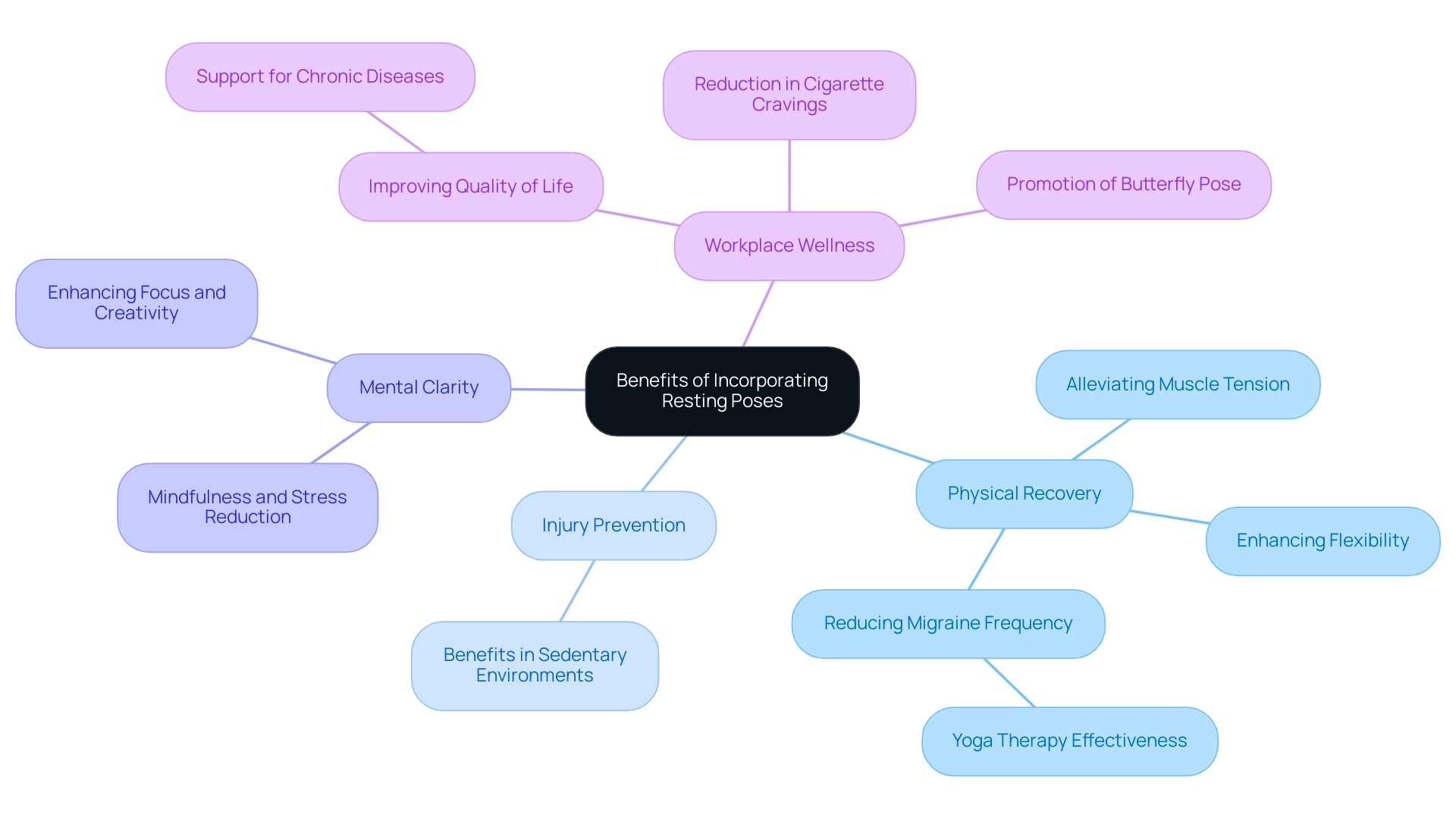
Modifications for Resting Poses: Tailoring to Your Needs
Tailoring resting poses to meet your unique needs is pivotal for reaping the full benefits. For example, if Child’s position feels uncomfortable, consider placing a bolster or cushion beneath your torso. This simple modification can make a significant difference in how you experience the pose.
Similarly, in Legs-Up-the-Wall position, adding a folded blanket under your hips can provide essential support and enhance comfort. Individuals grappling with tight hips may find relief by using blocks in the Reclining Bound Angle Pose, which can help alleviate strain and promote relaxation. Remember, the ultimate goal is to discover resting poses that feel right for you—ones that allow for complete relaxation and rejuvenation.
Embrace the exploration of different variations, as this personal approach is key to cultivating a sustainable and enjoyable routine. As George aptly states,
It’s clear that this practice is much more than just a physical exercise; it’s a holistic approach that can benefit both the mind and body and is accessible to people of all ages and backgrounds.
Additionally, statistics show that post-exercise diastolic blood pressure can average around 84.07 ± 8.94 mmHg, highlighting the physiological benefits of this practice.
Furthermore, a survey by the National Center for Health Statistics reveals that 1 in 3 Americans using complementary and alternative medicine report employing this practice for health reasons, such as back pain, anxiety, or depression. This demonstrates the widespread acceptance and therapeutic potential of this practice. Moreover, Tyagi and Cohen's review of literature on the practice and heart rate variability emphasizes that it promotes not only physical wellness but also mental health.
By prioritizing comfort and accessibility in your practice, you empower yourself and inspire those around you to embrace this transformative journey.
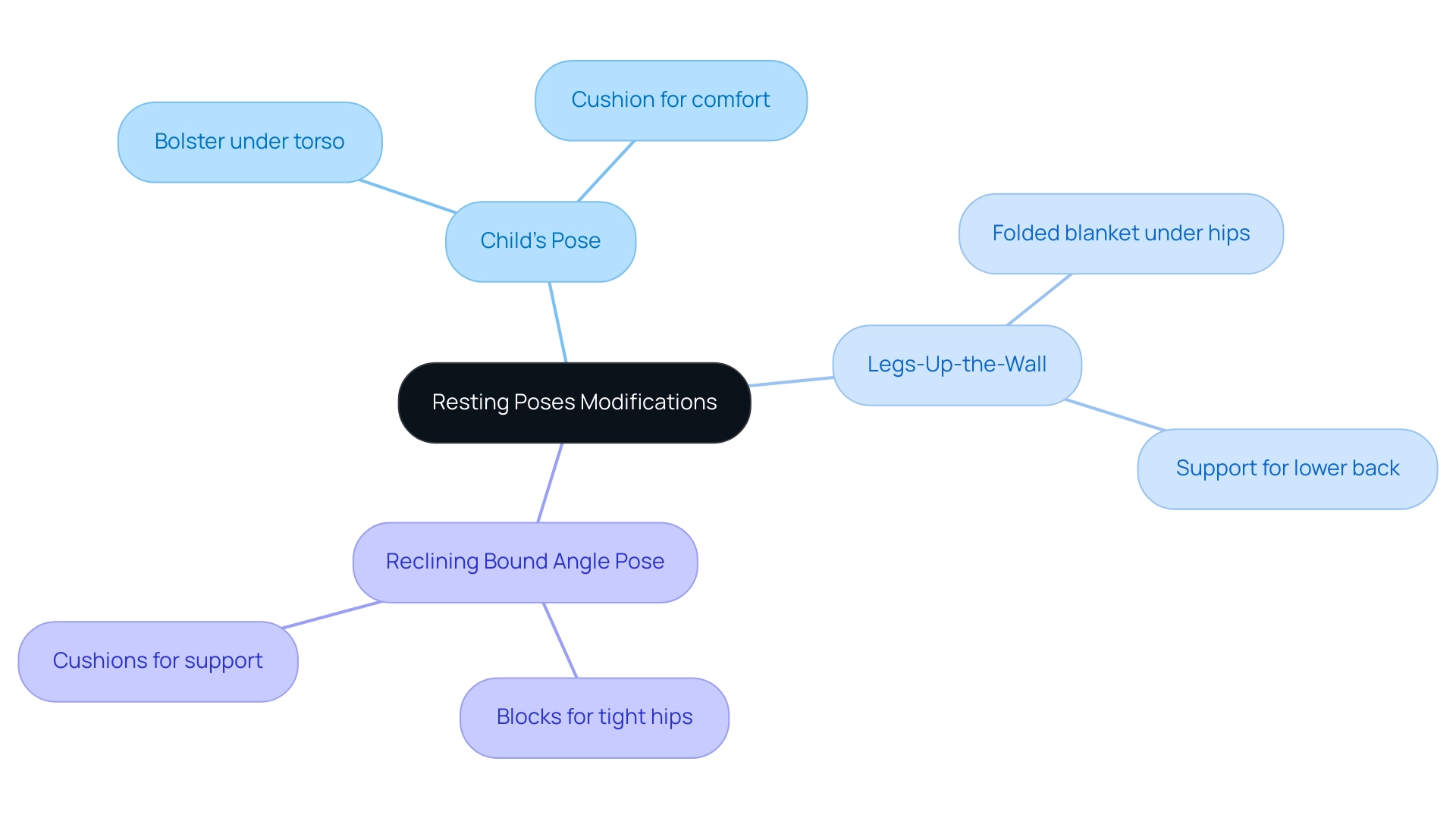
Using Props to Enhance Your Resting Poses
Incorporating props into your practice can transform resting poses into truly restorative experiences, enhancing comfort and effectiveness, especially for older practitioners, as 6.7% of individuals engaged in this activity in the U.S. are over the age of 65. For instance, placing a block under your hips during Supported Bridge Pose not only helps maintain proper alignment but also alleviates any unnecessary pressure. Similarly, a bolster strategically positioned under your knees in Savasana can offer valuable support to your lower back, fostering deeper relaxation.
Blankets can also play a vital role, providing warmth and comfort during seated poses, which helps to cultivate a tranquil environment. As DQ emphasizes, novices should learn and engage in exercises under supervision, ensuring they can execute postures correctly and safely, particularly when using props. By thoughtfully incorporating these props, practitioners can significantly deepen their relaxation during resting poses and promote a profound sense of peace throughout their sessions.
This method not only enhances the enjoyment of the activity but also aids in overall well-being, motivating individuals to welcome the numerous advantages of a mindful routine. Furthermore, research by Wolever et al. (2012) highlights that yoga is effective in reducing stress and improving physical measures, reinforcing the benefits of using props to enhance relaxation during yoga practice.
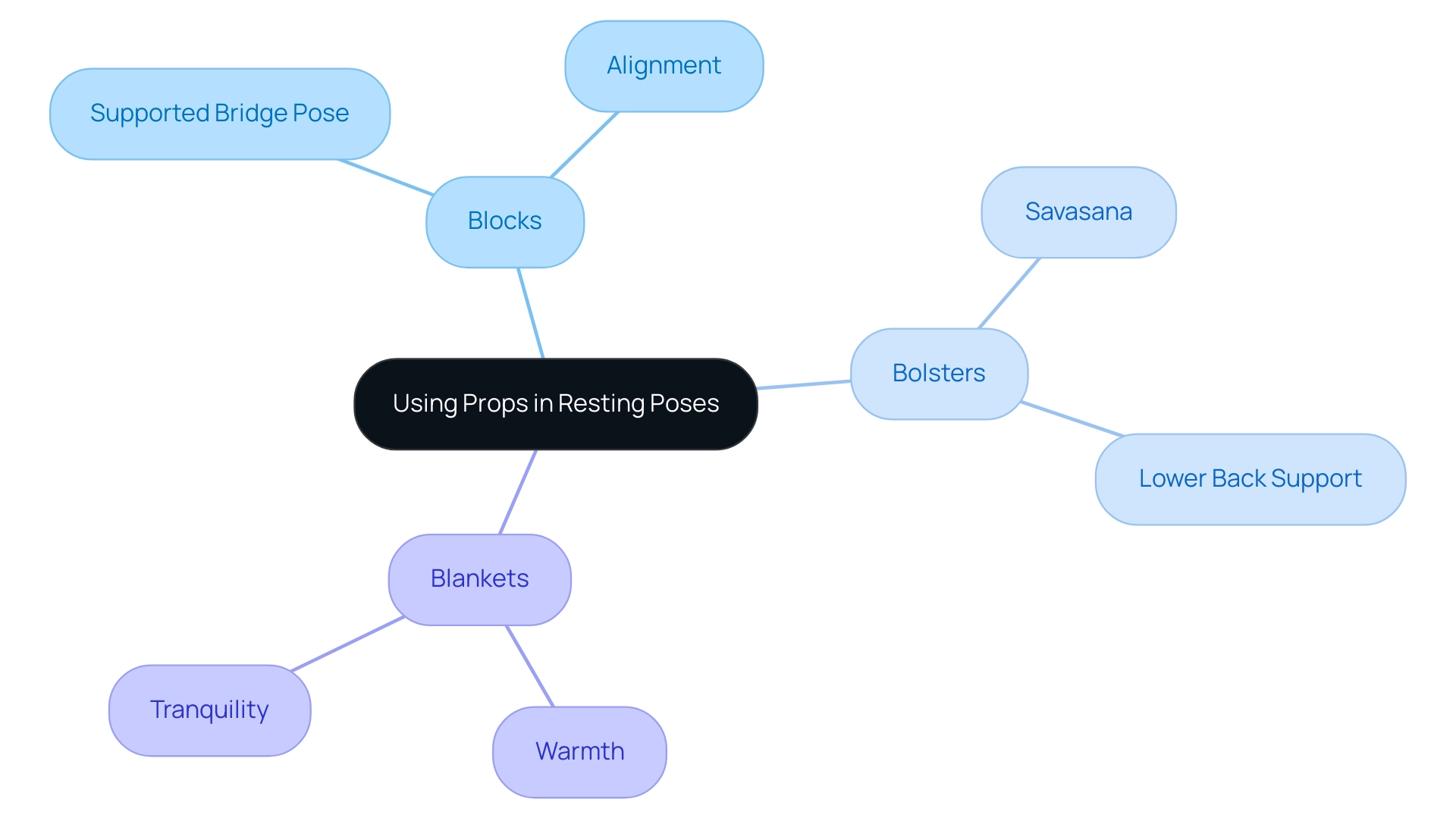
Conclusion
Embracing the practice of resting poses in yoga can be a game-changer for individual well-being and workplace productivity. These essential poses offer a sanctuary from the stresses of daily life, enhancing physical recovery, mental clarity, and emotional resilience. As highlighted throughout the article, incorporating simple yet impactful poses like:
- Child's Pose
- Legs-Up-the-Wall Pose
- Corpse Pose
can lead to significant improvements in both personal health and team dynamics.
The benefits of these restorative practices extend beyond the yoga mat. By fostering a culture that prioritizes well-being, organizations can inspire employees to engage more fully, ultimately enhancing job satisfaction and performance. Research indicates that regular practice not only alleviates physical tension but also cultivates mindfulness, leading to increased focus and creativity in the workplace.
To maximize the advantages of resting poses, it's crucial to tailor practices to individual needs and incorporate props for added support. This personal approach not only promotes comfort but also encourages a sustainable yoga practice that can be embraced by everyone, regardless of their experience level. By championing these restorative moments, HR Benefits Managers can play a pivotal role in nurturing a healthier, more engaged workforce, paving the way for success in both personal and professional realms. Now is the time to prioritize these practices, ensuring that employee well-being remains at the forefront of organizational values.




